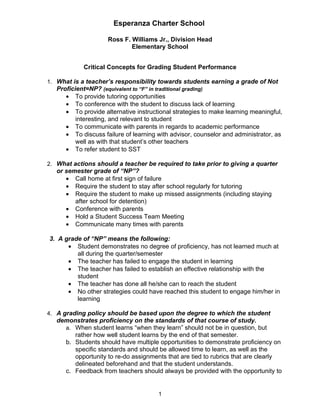Grading policy aug 20101
The document outlines grading policies and a teacher's responsibilities for students earning a grade of "Not Proficient" at Esperanza Charter School. It states that teachers must provide tutoring, communicate with students and parents, and try alternative instructional strategies before giving a grade of "NP." It also notes that "NP" means the student has not learned and the teacher has failed to effectively engage or teach the student. The document advocates for standards-based grading that reflects a student's demonstrated proficiency rather than averaging assignments, and allows multiple opportunities for students to retake assignments and learn. It also says that if most students do poorly on a test, the teacher should consider whether they effectively taught the material.

Recommended
Recommended
More Related Content
What's hot
What's hot (20)
Similar to Grading policy aug 20101
Similar to Grading policy aug 20101 (20)
More from gnonewleaders
More from gnonewleaders (20)
Recently uploaded
Recently uploaded (20)
Grading policy aug 20101
- 1. Esperanza Charter School Ross F. Williams Jr., Division Head Elementary School Critical Concepts for Grading Student Performance 1. What is a teacher’s responsibility towards students earning a grade of Not Proficient=NP? (equivalent to “F” in traditional grading) • To provide tutoring opportunities • To conference with the student to discuss lack of learning • To provide alternative instructional strategies to make learning meaningful, interesting, and relevant to student • To communicate with parents in regards to academic performance • To discuss failure of learning with advisor, counselor and administrator, as well as with that student’s other teachers • To refer student to SST 2. What actions should a teacher be required to take prior to giving a quarter or semester grade of “NP”? • Call home at first sign of failure • Require the student to stay after school regularly for tutoring • Require the student to make up missed assignments (including staying after school for detention) • Conference with parents • Hold a Student Success Team Meeting • Communicate many times with parents 3. A grade of “NP” means the following: • Student demonstrates no degree of proficiency, has not learned much at all during the quarter/semester • The teacher has failed to engage the student in learning • The teacher has failed to establish an effective relationship with the student • The teacher has done all he/she can to reach the student • No other strategies could have reached this student to engage him/her in learning 4. A grading policy should be based upon the degree to which the student demonstrates proficiency on the standards of that course of study. a. When student learns “when they learn” should not be in question, but rather how well student learns by the end of that semester. b. Students should have multiple opportunities to demonstrate proficiency on specific standards and should be allowed time to learn, as well as the opportunity to re-do assignments that are tied to rubrics that are clearly delineated beforehand and that the student understands. c. Feedback from teachers should always be provided with the opportunity to 1
- 2. learn and demonstrate that learning with corresponding credit for work completed. d. Standards-based grading that reflects student proficiency is NOT AN AVERAGING OF ALL ASSIGNMENTS BUT RATHER AN INDICATION AT THE TIME OF THE GRADE OF THE DEGREE TO WHICH THE STUDENT IS DEMONSTRATING WHAT HE/SHE IS EXPECTED TO KNOW AND BE ABLE TO DO TO DEMONSTRATE PROFICIENCY. e. No Zero’s for grades. Equal value for grades should be given such as the following which should reflect student demonstration of proficiency on “grade level appropriate work”. • A = 90 – 100% • B = 80 – 89% • C = 70 – 79% • NP = 50 – 69% 5. Assignments not submitted should be required to be submitted and students should be held after school or be required through some method to complete all assignments. Other grading scales could be the traditional 4-point scale of A=4 B=3 C=2 NP= 0 But on an average % scale no “killer zeros” as they damage a students opportunity for fairness. Therefore the lowest % score possible is 50%. (At present PS averages grades. Using 50% as the lowest % on an NP assignment is a more balanced weighting of assignments). 5. If a class of students performs poorly on a test, the teacher should consider how well he/she taught content for which the test was based upon. a. Students should not be held accountable for poor teaching. Student performance should be based upon effective instruction. b. When most students demonstrate lack of learning, the teacher should take responsibility for this and not penalize the students. 2